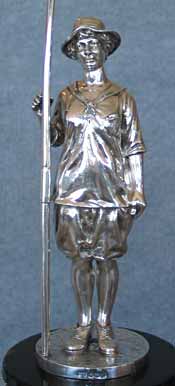History of Rowing Australia
Australian Women's Rowing Council
The women were separately represented by the Australian Ladies' Rowing Council, later the Australian Women's Rowing Council. This organisation amalgamated with the men's Australian Amateur Rowing Council during the period 1979-1982.
The Australian Women's Rowing Council, then styled the Australian Ladies' Rowing Council, was created before the AARC on 13 May 1920 at the Telegraph Chambers Brisbane. It arose from a meeting of representatives of the lady rowers of South Australia, New South Wales and Queensland and was called by Ethel Abercrombie, the Honorary Secretary of the Brisbane Ladies' Rowing Club.
Bill O'Chee wrote the following superb article on the formation of the Australian Ladies' Rowing Council.
Edris Marks: One of the Founders of Australian Women’s Rowing
By William O’Chee 13 May 2024
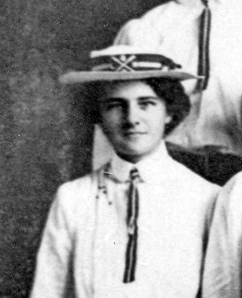
Today marks the 104th anniversary of the founding of the Australian Ladies Rowing Council, the world’s first governing body for women’s sport. William O’Chee looks at one of its founders.
In the grand sweep of history, much depends on the actions and decisions of a few individuals. For those few, history would not be what it is without the part played by coincidence.
In Brisbane on the 13th May 1920, a meeting took place which would have far reaching implications for women’s sport around the world. A collection of women rowers from Queensland, New South Wales, and South Australia, met in the offices of The Telegraph newspaper for the purposes of convening the first Australian Ladies Rowing Council (A.L.R.C.).
The resulting creation was the first national governing body for women’s sport anywhere in the world. Coincidentally, it preceded the foundation of the Australian Rowing Council – the A.L.R.C.’s male counterpart – by five years.
Although the meeting was convened at the request of Ethel Abercrombie, the Honorary Secretary of the Brisbane Ladies Rowing Club, there seems strong evidence that one of the prime movers was another Brisbane rower, Edris Marks.
The clue that Marks may have had more than a passing role in the formation of the Australian Ladies Rowing Council comes from her appointment as one of two Vice-Presidents serving alongside the President, Lady Helen Munro Ferguson.
Lady Munro Ferguson was the wife of the Governor-General of Australia from 1914 to 1920. The other Vice-President, Lady Weigall, was the wife of Sir Archibald Weigall Bt, the Governor of South Australia from 1920 to 1922. Both of these women were very much appointments of patronage and would not have been expected to do much real work in the running of the Council. Most importantly, neither of these women was an active participant in the sport. That left Edris Marks as the senior rower on the Council.
Women had been rowing in the State of Queensland since at least 1907, and the Brisbane Ladies Rowing Club was formed in May of that year. The membership of the club is an interesting study in and of itself. The lady members (for the club had a make advisory committee) included many who had family connections to the sport of rowing through their fathers or brothers. Others came to rowing by other means, and without any family connections.
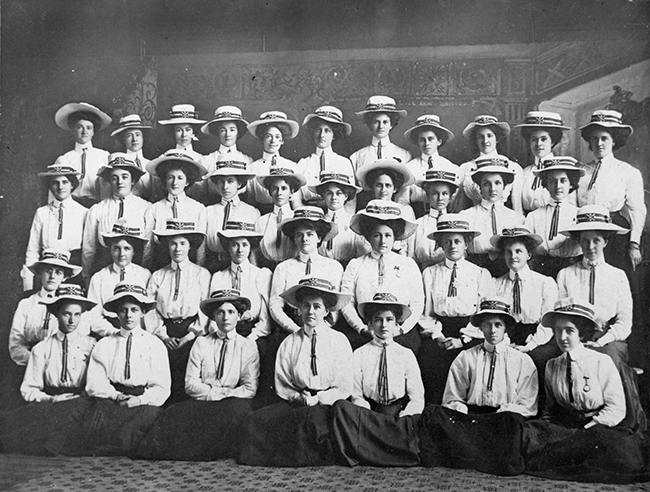
Brisbane Ladies Rowing Club members in 1910. Nesta Drury is on the left in the back row. Edris Marks is immediately in front of her.
Born in Brisbane in 1891, Edris Marks was one of those who came to rowing by her own endeavours. Her father, Charles Marks, was a prominent doctor and Member of the Legislative Council in Queensland. They resided at 101 Wickham Terrace at Spring Hill. Her brothers were students at Brisbane Grammar School, however rather than attending Brisbane Girls Grammar School, Edris was enrolled at the Brisbane High School for Girls (later Somerville House) in 1901. While Somerville House would eventually find a permanent home at South Brisbane, it was at that time located at the Baptist City Tabernacle on Wickham Terrace. This was a block from the Marks residence. Edris would remain a student at the school until at least 1907, when she was recorded as being in the Fifth Form. In all probability, she finished her schooling there the following year, for her father donated to the Swimming Prize Fund in 1908.
In the same year that Edris likely finished school, the Brisbane Ladies Rowing Club held its inaugural regatta in March. Events for women included coxed pairs over 200 yards, as well as handicap pairs, champion sculls, and double sculls, all over 300 yards.
Although, the club had strong support, its next regatta was not until May 1910, when Edris Marks was a competitor in the handicap pairs with her partner, Ernestine (Nesta) Drury. Marks and Drury were clearly the favoured combination in this event, as they were seeded directly into the final. In this race, they gave two seconds to the combination of Burston and Bell, who won by a margin of two lengths.
Nesta Drury was ten years older than Edris and came from a well-known rowing family. Her elder brothers, Edward, Noel and Arthur, were all successful rowers in the 1880s and 1890s. Noel rowed for Commercial Rowing Club, while Edward and Arthur rowed for Breakfast Creek Rowing Club, where the Brisbane Ladies Rowing Club was first based.
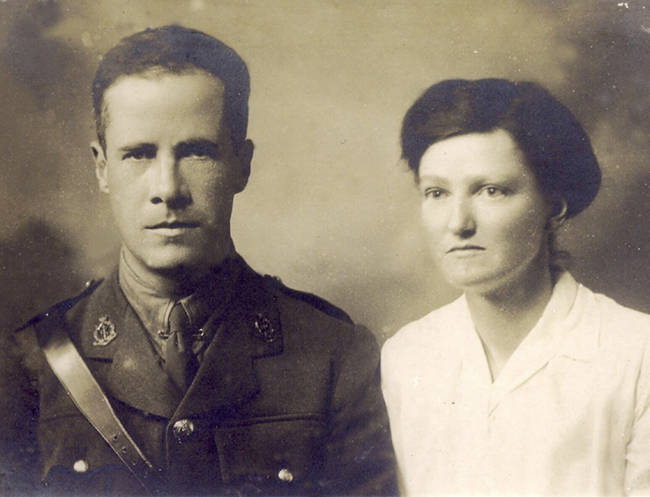
Ted and Nesta Marks after their wedding in 1916.
The paring of Edris and Nesta may have been prompted by the fact that Edris’s brother, Edward (“Ted”), was Nesta’s sweetheart. The pair were engaged in 1913 and married the following year in London. Edward was, at the time, studying in Dublin to be a doctor.
Coming from a medical family, the outbreak of the First World War saw Edris Marks swept up into the Voluntary Aid Detachment (V.A.D.), which provided nursing orderlies to hospitals, and played no small role in caring for repatriated soldiers. The V.A.D.s were under the purview of the Australian Red Cross Society, and it was here that coincidence would shape Edris’s future, and that of women’s sport in Australia.
The hundreds of V.A.D. members across the state required no small amount of organisation. With her considerable intellect and organisational ability, by 1917 Edris Marks had risen to be Quartermaster in the 1st Voluntary Aid Detachment. This effectively made her the second in command of the detachment to Zina Cumbrae Stewart, who was an executive member of the Australian Red Cross. By the end of the war, Edris Marks was the Detachment’s Commandant.
It seems it was through her Red Cross connections that Edris Marks was able to attract the support of Lady Munro, who had been President of the Australian Red Cross Society.
The A.L.R.C. would set a new standard in women’s sport, not only because it created a national governing body, but because its committee was made up entirely of women. Unlike other bodies of the time, it would not have a male President, nor a male advisory committee, as the Brisbane Ladies Rowing Club did. Quite simply, women were taking control of the promotion and the management of their sport, independent of the decisions made by the male dominated rowing councils in the states.
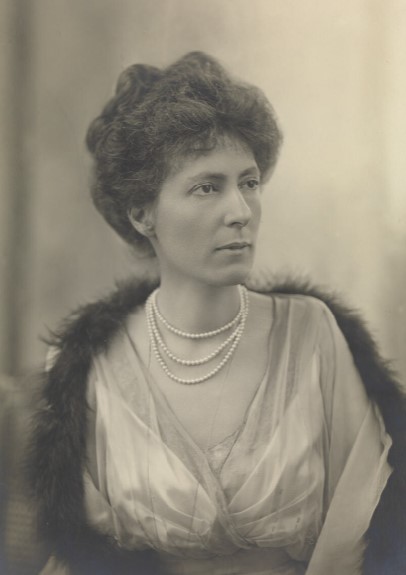
Lady Helen Munro Ferguson, first President of the Australian Ladies Rowing Council.
It was also blessed to have two Vice-Regal connections on its national committee. This would give women’s rowing immediate status and recognition.
In November 1920, Lady Helen Munro Ferguson would return with her husband to Britain at the end of his appointment as Governor General. The Australian Ladies Rowing Council, however, would be unperturbed by this change in leadership, and would continue to flourish, overseeing a growing women’s rowing community.
Edris Marks would also eventually retire from sports administration and devote her energies to helping run her father’s medical practice. Her role as an able administrator and networker placed Australian women’s rowing on the map and provided a template for other women’s sporting organisations around the world.
There is undoubtedly much more to be discovered about the early days of the Australian Ladies Rowing Council, but its debt to Edris Marks is clear.
On 15th May 1920 an Interstate Women's Fours race was conducted in conjunction with the Interstate men's eight race in Brisbane. A proposal to allow the conduct of an Interstate Women's Four Oared race at the Men's Interstate Championships was defeated at the Interstate Conference on 22nd April 1921.
Whilst this was the first official Interstate Championship, other Interstate contests were already being conducted. Below is a picture of a representative South Australian crew who won an interstate contest on Anzac Day in 1919.
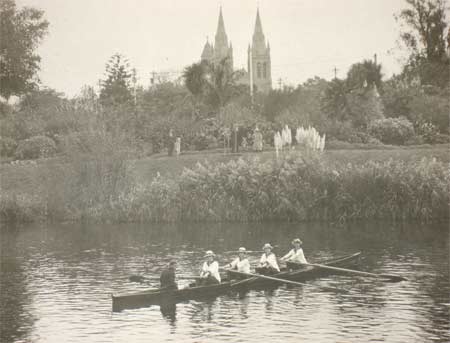
The victorious South Australian crew, winners of an Interstate Contest on 26th April 1919
Bow: M E Donnell, 2: V Rossiter, 3: M Thomas, Str: G Thomas, Cox: E R Kriehn
The following is extracted from Rose Evan's "Sixty Years of Women's Rowing 1920-1980":
"This year (1920) saw the presentation of the existing trophy for the Australian Champion Fours by the Queensland Branch of the Licensed Victuallers of the Commonwealth of Australia, as a perpetual trophy for annual, interstate races. Atop the trophy, cast in sterling silver, stands a young oarswoman, holding her oar and wearing the rowing fashion of that era, viz., wide-brimmed hat, sailor top, billowy bloomers and lace-up shoes and stockings. This trophy was made from one hundred silver guineas by a craftsman, who used as his model the stroke of South Australia's winning crew, Miss Dorothy Arnold. It is interesting to note that in the early 1960's a suggestion was put forward that the statuette be melted down, and a more modern version constructed in its place, but this met with such violent opposition from current oarswomen that the proposal was withdrawn. Affectionately known to Australian oarswomen as "Bertha", this trophy would most certainly be valued nowadays at considerably more than one hundred guineas."
The first Interstate Women's Race was conducted in 1901. Again we refer to Rose Evan's work:
"In 1901, the Women's Interstate Sculling Race was one of the many festivities. Contestants were from Victoria, with one Sydney sculler also participating. The event was won by Mrs. Cassie McRitchie in an open style skiff, which is still housed at a Victorian Women's Rowing Club. The trophy of rubies and pearls set in a gold bracelet was presented to the winning sculler by the Duke and Duchess of Gloucester. organised to celebrate Federation.
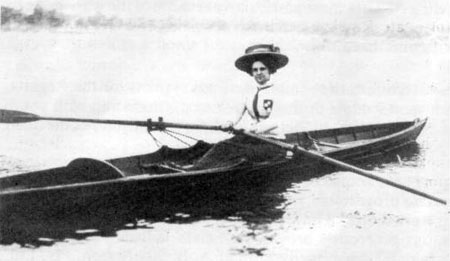
Cassie McRitchie in 1901 in the scull used to win the Inaugural Championship
"From that date, organised sculling competition at Interstate level lapsed until the Australian Women's Rowing Council decided to add the Championship event to their annual programme in 1963. The first Australian Women's Sculling Championship was staged at Brisbane, and the perpetual trophy known as the Nell Slatter Trophy was donated by the Oueensland Women's Rowing Association, and presented to the winner, Mrs. Helen Evans, of N.S.W."
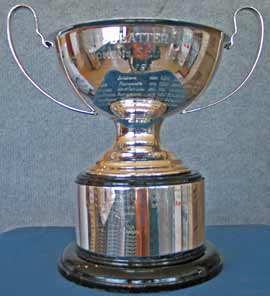
Nell Slatter Trophy
It is interesting to note that the first recorded women's race was at the Shoalhaven Regatta in NSW on Australian Day in 1865. Robyn Florance in her book Shoalhaven River Regattas 150 years - 1855-2005 records that Miss Marion Munro defeated Miss M McLaren in the third race of the day in single sculls and Miss Munro defeated Miss Conroy in the fifth. Womens boating was popular as a recreation through to the turn of the century but was not a sport until the towards the end of the Victorian era when it was deemed appropriate for women to participate in such activities.


